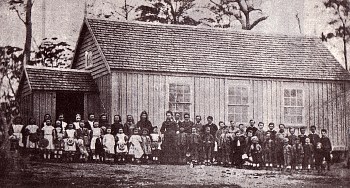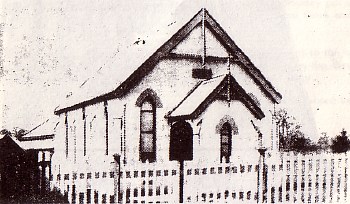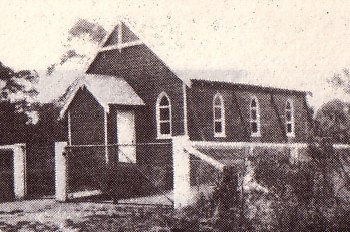OUR HISTORY
| Historical Background
Primitive Methodists and Wesleyans moved to the Highlands as closer settlement opened up with the advent of the southern railway - which led to the development of new towns - and as the Robertson Land Act made it possible for people to gain small holdings of land for farming, hitherto dominated by large pastoralists.
One of the earliest Primitive Methodists, Mr. John Piggott, moved to Throsby Park in Moss Vale in 1859 and held services in his home.
Most arrived with the large railway construction gangs in the early 1860s. They lived for months in tent camps along the route, and in their wake followed new settlers who set up businesses and service industries in the new villages of Mittagong, Bowral, Moss Vale, Exeter, Bundanoon, Penrose and Marulan. Mission workers often followed these gangs.
With the clearing of new land to the east, settlers began to establish small farms and villages in Kangaloon, Burrawang, Wildes Meadow and Robertson. Except for Bowral and Mittagong, most of these centres came at one time or another under the overview of the Moss Vale Circuit.
Historically, both Methodist denominations grew in Britain in the early 19th century, breaking earlier links with traditional Anglicanism and much influenced by European Calvinist and other evangelical movements, some as far back as the Puritans.
Both congregations emphasised personal relationship with scriptural teachings, evangelism, and an emphasis on community worship, missionary work and welfare. Both were to an extent anti-Catholic, anti-Anglican and involved in the teetotal movement.
They also made extensive use of lay preachers as opposed to an emphasis on an episcopal priesthood, although ordained ministers were appointed to districts and communities.
Consequently they gained popular followings among the working classes and the poor - the Primitives with labourers, servants, farm workers and miners, the Wesleyans with the lower middle class and artisans.
These peoples were among the huge exodus of migrants to Australia in the middle of the 18th century and it is not surprising to find them well represented among the earliest settlers of the new villages in the Highlands. |

The original Primitive Methodist church at Bundanoon, 1870s

Moss Vale Wesleyan Methodist church, built 1888.

The second Wesleyan Methodist church at Penrose (1911 - 39).
|
The Earliest Communities
The Wesleyans formed a 'Berrima Circuit' as early as 1864, its first minister Rev. George Lane of Mittagong. His jurisdiction probably covered most of the area, which was referred to as 'Berrima District' for the next 100 years.
Primitive Methodist familes settled in Bundanoon in the 1860s and Penrose in the 1880s. Wesleyans in Robertson and Kangaloon in the 1860s and Moss Vale in the 1880s. It was in these centres that lay preachers fostered development of the communities and in many cases built the first of their churches.
Primitive Methodist services in Bundanoon were held in the home of lay preacher Walter Grice (1868) and within five years the community had built a substantial wooden slab and shingle church (on the site of the current Memorial Hall). A photo of it shows a sizeable crowd of worshippers. This was also the first local school. It was replaced by the current church in 1885. Ministers have served there since the 1890s.
Wesleyan cottage services in Moss Vale were held by a lay preacher from Bowral from the earliest days, then in the first church (1881). A new church in Argyle Street was built in 1888. Ministers visited from Bowral (Moss Vale was then part of Bowral Circuit) and there was a local lay preacher, H. Coleman, until the first local minister was appointed in 1915. In 1937 the church grounds were extended and a new church built on to the original (now the church hall).
A Wesleyan church of timber slab construction was erected in Hoddle Street, Robertson around 1870. The original church was rebuilt in 1888, then replaced in 1902 by the present church. A substantial manse was built next door for a minster in 1896. Robertson was proclaimed a Circuit in 1888, having responsibility for the Wesleyan churches erected in Kangaloon (1865 - replaced by the current stone church in 1883) and Wildes Meadow (1874).
In the 1880s Penrose was opened up to small farms (mostly orchards) and many of the settlers were Primitive Methodists. In 1892 a timber church was re-erected at Cable's Siding, a few kilometres from the current village. This building was relocated from Moss Vale (and originally Bowral) where it had previously been used by the church.
In 1911 this was replaced by a new church, which was then moved closer to Penrose Station in 1924. This church was lost in a bushfire in 1939.
A new church was quickly built the same year, with a church hall built by volunteer labour in 1953. Services were suspended in Penrose in 1975.
The Moss Vale Circuit
Moss Vale was part of the Bowral Circuit until its own circuit was created in 1915 when full time ministers were appointed. The town was by then one of the largest in the Highlands.
In 1902 the Wesleyans, Primitive Methodists and United Free Methodist Churches in Australia united, so both local representatives came under the same administration.
The first communities of the Moss Vale Circuit included Exeter, Bundanoon and Penrose. Others were later added.
Robertson had its own circuit until 1975, being then incorporated into Moss Vale; its administration of Kangaloon (1888 - 1975) passed to Bowral and the little church at Wildes Meadow had closed.
Exeter had held services in the local School of Arts on and off over the years from 1915 to mid century, but a church was never built there.
Small churches at Penrose and Tallong succumbed to devastating bush fires in 1965 and were not replaced.
In June 1977 Methodists, Congregationalists and Presbyterians came together as the Uniting Church of Australia of which the Moss Vale Circuit is now a part.
Today the circuit has churches in only Moss Vale, Bundanoon and Robertson, and one minister. Services are held regularly at Moss Vale, monthly at Bundanoon (services at Robertson were suspended in 2008). All centres have regular fellowship meetings.
Mission and Outreach
The churches - past and present - of the Moss Vale Circuit have a proud history of mission and outreach to their local communities.
The first school in Bundanoon was in one of their churches, and every centre had well organised Sunday Schools for children.
Family picnics, community fairs, fetes and other social gatherings were part of every church calendar. Choirs and Women's groups were an important part of the church's fabric - some notable members of the latter serving up to the age of 100! Moss Vale remains a centre of community welfare activities.
For many years churches were shared - with Presbyterians at Bundanoon (until 1959 when a separate church was built, re-integrated in 1975) - and Anglicans at Penrose. The church at Bundanoon is currently being shared with a new Baptist community. Other communities have asked for and received support.
Early services were held by a minister in the old courthouse in Berrima, but having only a small congregation he went to Mittagong. Moss Vale was asked to administer to the town in 1929 when services were held at Medway Colliery. These continued in a private house until the late '60s. Many of its worshippers worked at the Cement Factory). Land was put aside in New Berrima for a church, but it was never built.
At Tallong a small church was built (originally part of the Marulan Home Mission Circuit) and asked, in 1918, to join Moss Vale. It held a Sunday School for many years. Despite all attempts to maintain the building and with a falling congregation, the church burnt down in 1965 and was not replaced.
In 1878 land was put aside at Big Hill (near Marulan) for a Primitive Methodist Church and cemetery. A small church was apparently built here - to be used freely also by Presbyterians. This community, originally part of the Goulburn Circuit, came under Bowral in 1902, then Moss Vale in 1918. It seems Moss Vale was servicing this community until the 1930s, after which it was being visited from Goulburn - of which it is now a part.
Today the Moss Vale Circuit of the Uniting Church continues to reach out to members of its community.
Credits: © 2010 G.A. Hinde
History pages by the author in www.highlandsnsw.com.au; "100 Years at Bundanoon" (1985) ed. Geraldine Leonard, Bundanoon Uniting Church Centenary Committee; "Moss Vale Methodist Circuit - Its History and its People" (1975) ed. Geraldine Leonard, Moss Vale Uniting Church; "A History of the Berrima District 1798 - 1973" (1962) James Jervis; details on Bowral and Kangaloon history - www.bowral.unitingchurch.org.au'; details on the histories of the Wesleyan, Primitive and Congregational churches - Wikipedia; details of early Methodist Mission, 1880s (SMH, Adelaide Advertiser, Brisbane Courier) - newspapers.nla.gov.au; personal anecdotes from community members of the Moss Vale, Robertson and Bundanoon churches. Photographs © Furry Software IT; Ken Pogson; archives of Moss Vale Uniting Church Circuit.
Corrections, updates and illustrations of items most welcome.